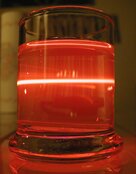
Tyndall effect (also known as Tyndall scattering) is a light scattering by particles in a colloid or a fine suspension. Example of Tyndall effect includes the visible beam of headlight in a foggy night.
Tyndall scattering is similar to the Rayleigh scattering. The fundamental difference is that the scattering particle is much smaller than the wavelength (less than one tenth) in Rayleigh scattering, while the scattering particle is much larger (comparable to wavelength) in Tyndall scattering. Rayleigh scattering model is simple but lose the accuracy when the particle size becomes large. Mie theory can handle well these scattering problem, especially when the scattering particle has spherical shape The Tyndall scattering is much more stronger than the Rayleigh scattering. This makes sense that with the same particle size, the shortwave length give stronger scattering effect. This is the reason why color of scattered light usually has a bluish tint and the sky looks blue (blue light scatters better than red light).
The Tyndall effect can help us to differentiate types of mixtures, namely solution, colloid, and suspension. In a liquid suspension, the tyndall effect can be easily noticeable by using a laser pointer, as the laser beam can be seen as it travels through the liquid.
“For any particular particle size, tyndall will increase linearly with concentration (ppm). However since tyndall will increase to the third power of particle size for any given concentration, it is very difficult to use tyndall to determine concentration of a sol. Tyndall can really only be used as a go/no go test to determine if a colloid is present, not its concentration. For instance, if you have a 1 ppm sol of 10 nm particles, the tyndall will be 100 times brighter than a 10 ppm sol of 1 nm particles, instead of 1/10 as bright. This is a good test to run since the highest quality CS will be crystal clear, and thus hard to distinguish from pure water.” (Source: http://silver-lightning.com/tyndall/)
While applications of tyndall effect include the determination of particle size and density in colloidal system (such as aerosols). Commercially, there are ultramicroscope and turbidimeter.
Here is an very interesting example how to setup a homemade system to measure optical signals and compare them to the Mie theory predicted curve too determine the particle size. Particle Size Determination using the Tyndall effect and Mie scattering theory.
Light scattering
- Elastic scattering
- Rayleigh scattering
- Tyndall scattering
- Inelastic scattering (Raman scattering)
- Stokes scattering
- Anti-Stokes scattering
Light scattering can be used to study colloidal system by using of Dynamic light scattering (DLS) technique. DLS can determine size distribution profile of particles in suspension or polymer in solution. DLS will be discussed in another post.